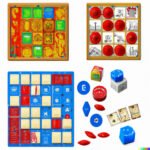Remember those afternoons spent huddled around a game board, strategizing and competing with friends? Classic school board games have long been a beloved pastime for many, and their timeless appeal continues to endure.
From fostering critical thinking to promoting social interaction, these games hold a special place in our hearts and memories. In this article, we will delve into the fascinating world of classic school board games, exploring their origins, educational benefits, popular choices, and their relevance in today’s digital age.
School board games have been a staple in households and classrooms for generations, captivating players of all ages with their engaging gameplay and simple yet entertaining concepts. Whether it’s navigating through Candy Land or buying up property in Monopoly, these classic games offer not only hours of fun but also valuable learning opportunities. As technology continues to dominate entertainment, the enduring popularity of these timeless favorites speaks volumes about their enduring appeal and significance.
In the following sections, we will take a closer look at the history of classic school board games, tracing their evolution from traditional tabletop entertainment to modern-day adaptations. We will also explore the educational benefits of these games and how they help enhance cognitive skills in both children and adults.
Additionally, we will provide insights into selecting the right classic school board game for your child along with tips for incorporating these games into classroom settings. Join us as we embark on a journey to rediscover the nostalgic charm and enduring relevance of classic school board games.
History of Classic School Board Games
Classic school board games have been a staple in childhood entertainment for decades, providing hours of fun while also promoting learning and social interaction. The history of classic school board games can be traced back to ancient civilizations, where games like Senet in Egypt and Mehen in Mesopotamia were played. These early board games served as both entertainment and a means of teaching important skills such as strategy and decision-making.
During the 19th century, the rise of the middle class led to the production of mass-market board games, including perennial favorites like Chess, Checkers, and Snakes and Ladders. The late 19th and early 20th centuries saw the introduction of iconic games such as Monopoly, Scrabble, and Clue, which have remained popular to this day. The evolution of classic school board games continues with the advent of modern classics like Settlers of Catan, Ticket to Ride, and Pandemic.
The enduring appeal of classic school board games lies in their ability to bring people together for a shared experience while also challenging their mental acuity. These timeless games not only provide entertainment but also teach valuable life skills such as critical thinking, decision-making, and social interaction. As technology continues to advance, classic school board games remain a beloved pastime for families and classrooms alike.
The Educational Benefits of Classic School Board Games
Classic school board games have long been recognized for their educational value, particularly in the development of cognitive skills in children. These games provide opportunities for players to practice critical thinking, problem-solving, strategic planning, and decision-making, all of which are essential for academic success and overall cognitive development. Through engaging with classic school board games, children can enhance their memory, concentration, and spatial reasoning abilities.
Studies have shown that playing classic school board games can have a positive impact on a child’s academic performance. For example, games like Scrabble can improve vocabulary and language skills, while chess has been linked to improvements in mathematics and analytical thinking.
Additionally, cooperative board games like Pandemic or Forbidden Island encourage teamwork and communication skills among players. By incorporating these games into educational settings, teachers and parents can effectively support children’s learning in a fun and interactive way.
Furthermore, classic school board games also contribute to the social and emotional development of children. Playing these games fosters sportsmanship, patience, and resilience as players learn to cope with both winning and losing. Moreover, the face-to-face nature of board game play encourages social interaction and strengthens relationships among peers. Overall, classic school board games serve as valuable tools for holistic development in children by nurturing both their cognitive and socio-emotional growth.
| Educational Benefits | Enhanced Skills |
|---|---|
| Critical Thinking | Problem Solving |
| Strategic Planning | Decision Making |
| Memory Enhancement | Improved Concentration |
Top 5 Classic School Board Games
In recent years, classic school board games have experienced a resurgence in popularity, with both children and adults rediscovering the joys of these traditional forms of entertainment. These timeless games not only provide hours of fun and social interaction but also offer numerous educational benefits, making them a valuable addition to any family or classroom setting. Here, we take a detailed look at the top 5 classic school board games that continue to captivate players of all ages.
1. **Chess:** With origins dating back to the 7th century, chess is a game of strategy and critical thinking that has stood the test of time. It helps develop cognitive skills such as problem-solving, planning, and foresight, making it a favorite among educators and parents alike.
2. **Monopoly:** This iconic economic simulation game has been entertaining players since its introduction in 1935. Monopoly teaches basic math skills, strategic thinking, and decision-making while offering an engaging lesson in capitalism.
3. **Scrabble:** A word game that challenges players to create words from lettered tiles on a grid board, Scrabble promotes literacy skills, vocabulary expansion, and mental agility. It remains a beloved pastime for families and classrooms.
4. **Candy Land:** Designed for younger children, Candy Land is a colorful race-to-the-finish game that introduces youngsters to rules and turn-taking while reinforcing color recognition and counting skills.
5. **Clue:** A murder mystery game that requires deductive reasoning and logical thinking, Clue engages players in solving a fictional crime by narrowing down suspects, weapons, and rooms through strategic questioning.
The enduring appeal of these classic school board games lies not only in their entertainment value but also in their ability to facilitate learning in an enjoyable manner. Their continued popularity serves as a testament to their timeless relevance in promoting cognitive development among players of all ages.
How to Choose the Right Classic School Board Game for Your Child
When choosing the right classic school board game for your child, there are several important factors to consider. Here are some key elements to keep in mind:
- Age Appropriateness: Consider the age of your child and choose a game that aligns with their developmental stage. Games that are too advanced may frustrate younger children, while games that are too simple may bore older kids.
- Educational Value: Look for games that offer educational benefits such as literacy development, math skills, strategic thinking, and problem-solving. Many classic school board games provide opportunities for learning in an enjoyable way.
- Interest and Engagement: Take into account your child’s interests and hobbies when selecting a game. Whether they enjoy science, history, or fantasy themes, there is likely a classic board game that will capture their imagination.
It’s also important to consider the social aspect of playing board games. Cooperative games can encourage teamwork and collaboration, while competitive games can teach good sportsmanship and strategic thinking.
Lastly, consider the length of the game and the number of players it accommodates. Some classic school board games are quick and easy to play, while others require more time and concentration. Additionally, if you have multiple children of different ages, it’s helpful to choose a game that can be enjoyed by all members of the family. By considering these factors, you can select a classic school board game that will provide entertainment, education, and quality family bonding time.
Tips for Introducing Classic School Board Games in the Classroom
Introducing classic school board games in the classroom can be an excellent way to incorporate fun and learning into the curriculum. These timeless games not only provide entertainment but also offer numerous educational benefits for students. By incorporating classic school board games into the classroom, teachers can create an interactive and engaging learning environment that promotes critical thinking, problem-solving, and social skills.
Benefits of Incorporating Classic School Board Games
One of the main benefits of introducing classic school board games in the classroom is that they encourage strategic thinking and decision-making. Games like Chess, Scrabble, and Monopoly require players to think ahead, make calculated moves, and consider various possibilities – skills that are valuable for academic success and real-life situations. Additionally, these games promote healthy competition and teach students how to win gracefully and lose graciously.
Furthermore, classic school board games also help develop social skills among students. Many of these games require interaction with others, fostering communication, teamwork, and sportsmanship. For example, playing cooperative games like Pandemic or The Game of Life can teach students the importance of collaboration and compromise. By incorporating these games into classroom activities, teachers can create a positive and inclusive learning environment that encourages peer interaction.
Tips for Introducing Classic School Board Games in the Classroom
When introducing classic school board games in the classroom, it’s important to consider the age group and skill level of the students. Selecting appropriate games that align with the curriculum and cater to the students’ abilities will ensure an enjoyable learning experience.
It’s also beneficial to incorporate these games as part of a lesson plan or as a reward for good behavior or academic achievements. Moreover, providing clear instructions and setting expectations for gameplay will help maintain orderliness during game sessions.
In addition, teachers can use classic school board games as a starting point for discussions on various topics such as history, mathematics, language arts, or social studies. By integrating game-related lessons into the curriculum, educators can further enhance student engagement and knowledge retention. Overall, introducing classic school board games in the classroom involves thoughtful planning and creativity to maximize their educational value while creating a fun learning environment for students.
DIY Classic School Board Game Ideas
Materials and Supplies
When it comes to creating your own classic school board game, one of the first steps is gathering the necessary materials and supplies. Depending on the game you have in mind, this could include a variety of items such as cardboard, markers, dice, playing pieces, and more. Consider what you already have at home or what can be easily obtained from a craft store to keep costs low.
Brainstorming Game Concepts
Before diving into the creation process, take some time to brainstorm different game concepts. Consider classic board games like Snakes and Ladders, Chess, Checkers, or even your own twists on popular games like Monopoly or Scrabble. Think about what educational elements you want to incorporate and how to make the game both fun and engaging for players.
Design and Testing
Once you have settled on a game concept, it’s time to design the game board and components. This could involve drawing out the board layout, creating playing cards, or designing any other necessary elements. After creating your prototype, it’s important to test the game with friends or family members to identify any potential issues or areas for improvement before finalizing your DIY classic school board game.
By following these steps and tapping into your creativity, you can create an educational and entertaining DIY classic school board game that can be enjoyed by children both at home and in the classroom. Whether it’s a simple counting game for younger kids or a more complex strategy-based game for older students, homemade board games offer a budget-friendly way to enhance learning through play.
The Future of Classic School Board Games
In conclusion, classic school board games have proven to stand the test of time and remain relevant even in today’s digital age. While technology continues to advance and offer new forms of entertainment, the appeal of sitting down with a physical board game remains strong. The social interaction, critical thinking, and educational benefits that come with classic school board games cannot be easily replaced by screens and virtual experiences.
Despite the pervasive use of smartphones and video games, many parents and educators recognize the value of classic school board games in promoting meaningful connections and developing essential skills in children. These games provide a break from screen time and offer a valuable opportunity for families and friends to engage in face-to-face interactions while having fun.
As such, it is clear that classic school board games will continue to have a place in our society for years to come.
As we move forward into an increasingly digital future, it is important to remember the enduring benefits of classic school board games. Whether it’s through cognitive development, social bonding, or just good old-fashioned fun, these timeless games have much to offer. By introducing them into our classrooms, homes, and communities, we can ensure that the tradition of playing classic school board games lives on for future generations to enjoy.
Frequently Asked Questions
What Is the Most Popular Traditional Board Game?
The most popular traditional board game is considered to be chess. It has a long history, dating back to the 6th century, and is played by millions of people worldwide. Chess is known for its combination of strategy, skill, and intellectual challenge, making it a favorite among traditional board games.
What Is the Main Classic Board Game?
The main classic board game would likely be Monopoly. This game has been around since the early 20th century and has remained popular throughout the years. With its iconic gameplay centered around buying and trading properties, Monopoly has become a staple in the world of classic board games.
How Do I Find an Old Board Game?
Finding an old board game can be done through various methods. One option is to check with local thrift stores, antique shops, or online marketplaces such as eBay or Etsy.
Another possibility is to attend flea markets or garage sales where vintage board games are often sold. Additionally, reaching out to collectors or gaming enthusiasts through social media platforms or dedicated forums may also yield positive results in locating old board games.

I love playing all kinds of games – from classics like Monopoly to modern favourites like Ticket to Ride.
I created this blog as a way to share my love of board games with others, and provide information on the latest releases and news in the industry.





